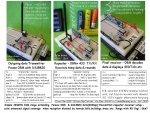elsey.jack
New Member
Hello everyone,
I am building a weather balloon for a research project. It will be tethered and float at a maximum height of 100 M. I plan to have it transmit the temperature via radio to a hand held unit.
I was using a pair of walkie-talkies for transmitting the signal, but I think that I may have just fried one trying to modify it for my nefarious purposes.
Before I go and sink another $25 on a walkie-talkie set, does anybody have any suggestions for RF modules that I could get instead? Can you buy a paired transmitter and receiver? How expensive would such a system be?
Also, will transmitting the signal via an RF module change the frequency of the signal sent?
Thanks,
Jack
I am building a weather balloon for a research project. It will be tethered and float at a maximum height of 100 M. I plan to have it transmit the temperature via radio to a hand held unit.
I was using a pair of walkie-talkies for transmitting the signal, but I think that I may have just fried one trying to modify it for my nefarious purposes.
Before I go and sink another $25 on a walkie-talkie set, does anybody have any suggestions for RF modules that I could get instead? Can you buy a paired transmitter and receiver? How expensive would such a system be?
Also, will transmitting the signal via an RF module change the frequency of the signal sent?
Thanks,
Jack

